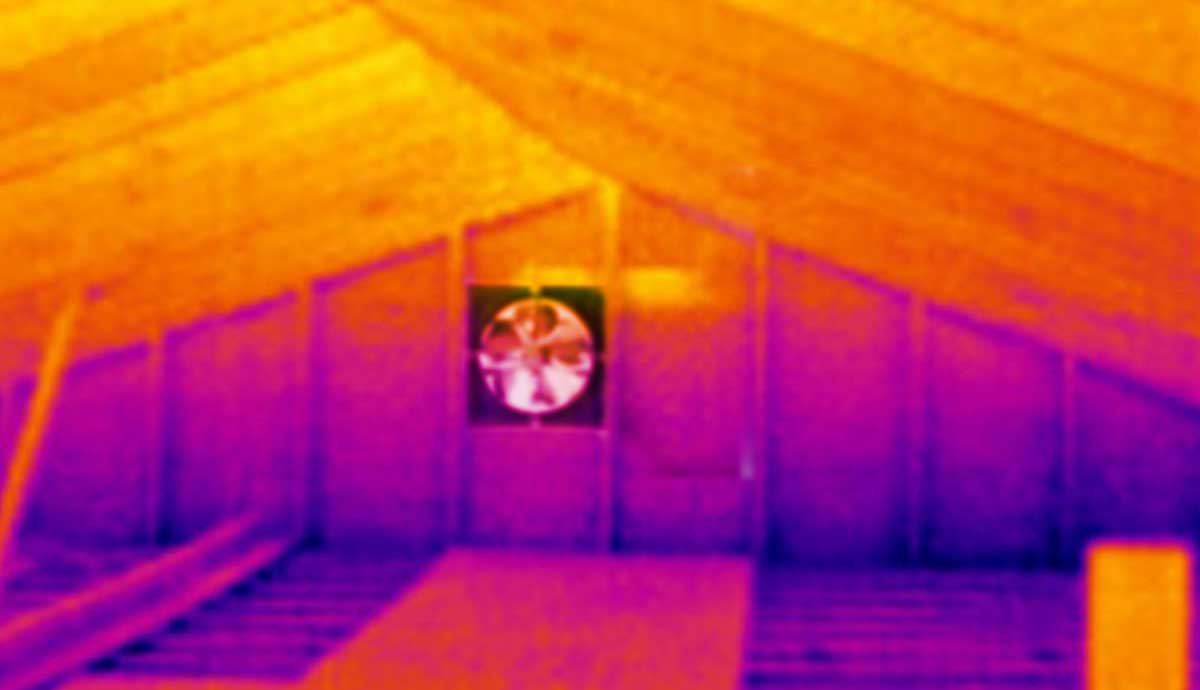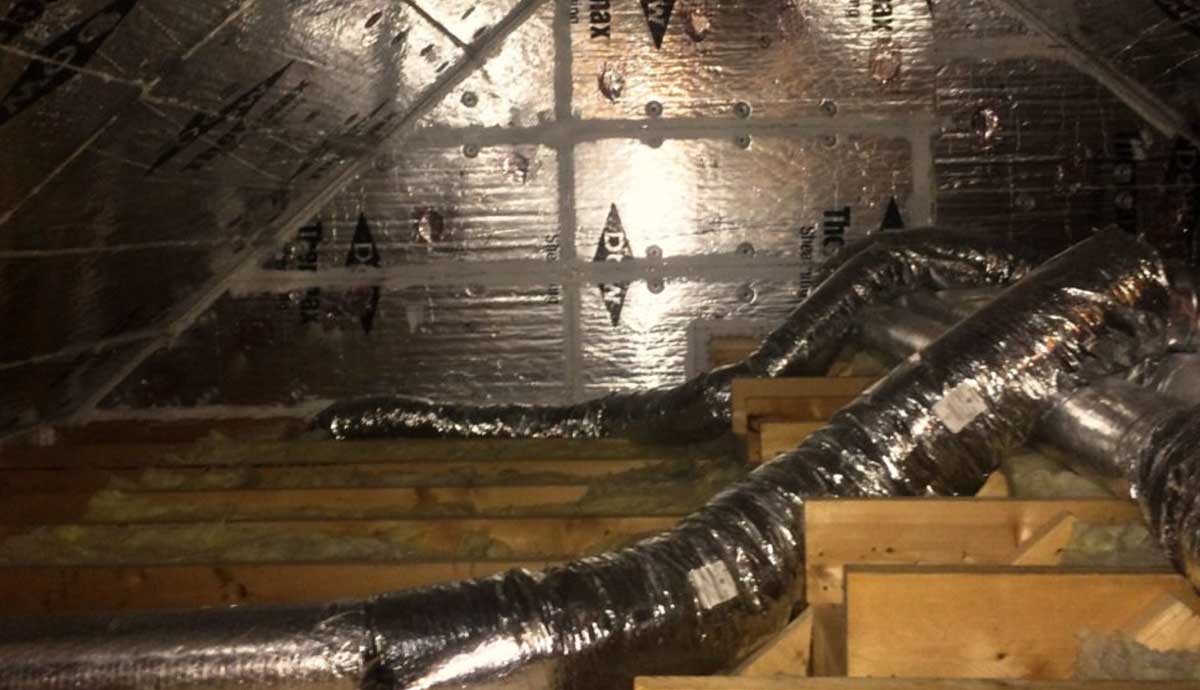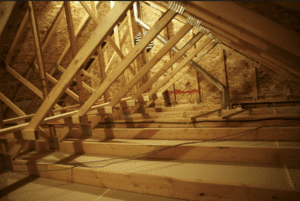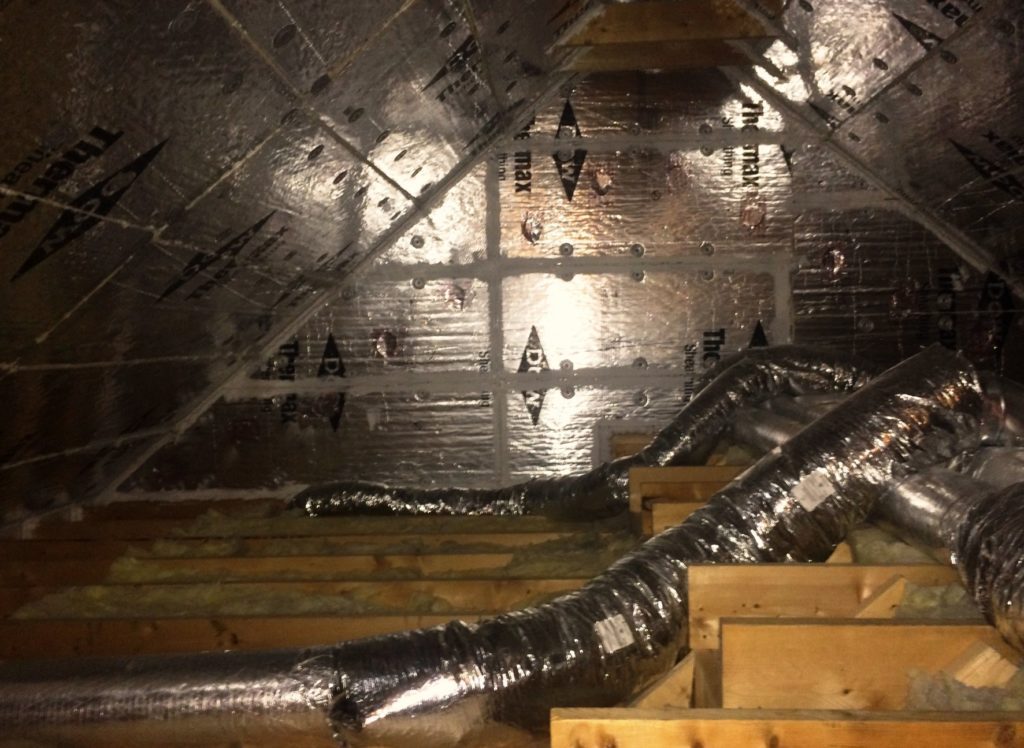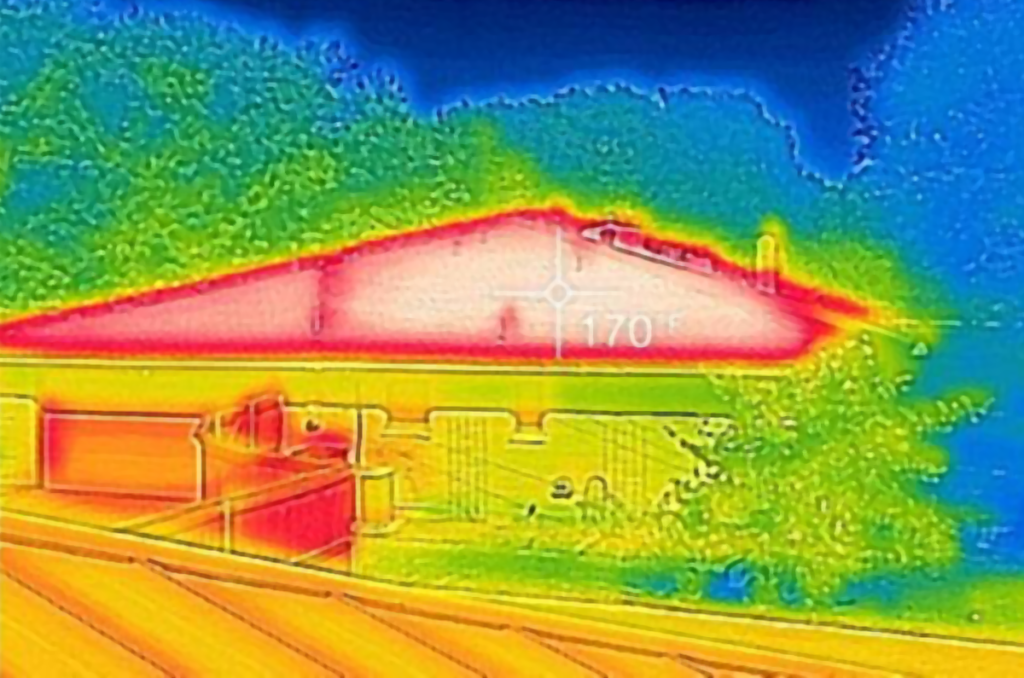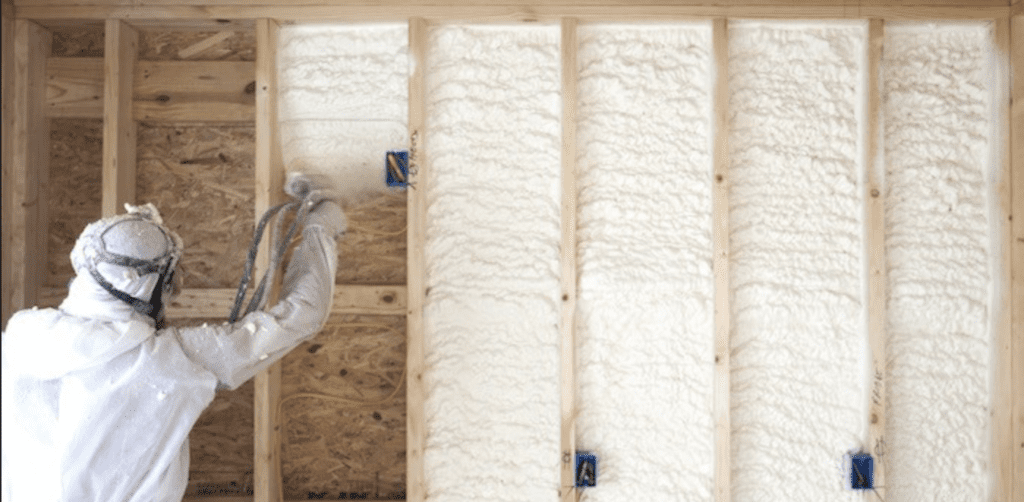Why attic fans don’t work well and what to do instead!
With the summer season upon us, now is a good time to review an uncomfortable topic. Hot attics, and why traditional attic fans don’t work well enough to cool them off! Continue reading to learn why…or just skip ahead to learn how to cool them off here.
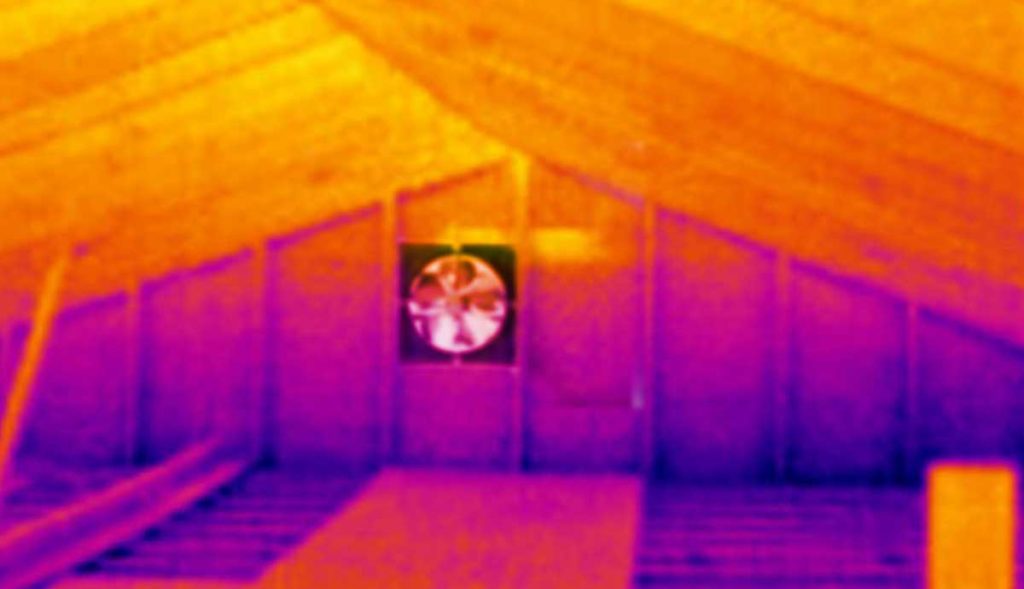
A very hot problem
Last week we had some warm weather for the first time this year. One of our clients called to say that their second floor was extremely hot and requested we install a larger and more powerful attic fan. The client had decided a new fan was needed to replace a solar unit they had installed several years ago. The solar fan “didn’t seem to be working as it should.” Compared to the rest of the house, the second-floor rooms were extremely hot and impossible to live in during the afternoon and evening.
Attic construction
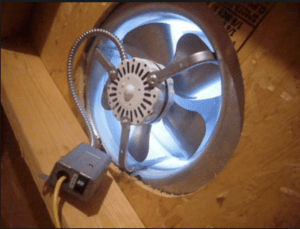
On inspection, I found the villain in the attic exactly as the customer described. A single, roof mounted, solar powered attic exhaust fan. It was working.
There was no other ducting or HVAC equipment in the attic. Insulation was a 6”-8” layer of blown-in fiberglass on the top of the ceiling, plus random pieces of R-19 fiberglass batts tossed askew atop the blown-in material, but not fully covering the space.
The 2×6 roof rafters with 4” skip sheathing, and ½” plywood shear was all fully exposed to view. 6”x24” eave vents were installed around the perimeter every 8’ and vents were clear and unblocked by the insulation. The temperature of the roof sheathing inside the attic was 147 degrees. The 45’x24’ (approx. 4500 cubic foot) attic space was very hot.
I explained to our client that the idea of attic fans to remove hot air from the attic area might seem logical. But they actually might need a bigger and better solution
Anatomy of attic heat
Imagine yourself laying in the sun on a beach in Cancun. All is good for about 5 minutes then you start to feel hot. You go and get a big fan and set it up to blow air over you. Ah, feels better for about another 5 minutes. Soon even the blowing air feels hot, so you exchange the fan for an air conditioner and let that blow cold air on you. Feels great now so you stay out in the sun till you notice that your skin is red and blistered and burned to a crisp.
What happened? You got zapped by UV rays, a form of invisible radiant heat! It’s why you can still get a terrible sunburn even on a cold or cloudy day. Radiant heat zips right through cold air without any affect and cooks your skin. So, what does that have to do with your house?
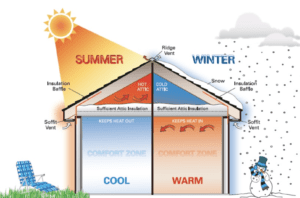
The roof structure of your home is like your skin. Radiation from the sun heats the surface of the roof. From there, the entire mass of the roof (roofing, roof paper, nails, sheathing, rafters) warms up through conduction. Soon the roof’s structural mass is so hot that it will radiate heat on its own (like the sun). This radiant heat passes down through the attic space and hits the material on the surface of the ceiling structure (insulation, wood joists, drywall, ducting etc.). Very quickly the entire mass of the ceiling structure also becomes a giant heat radiator. This heat moves back up towards the roof again and will continue to radiate heat well after the sun goes down. If your ceiling is not sealed airtight and extremely well-insulated, much of this heat is going to radiate downward into your home too.
Hot air
Air in the attic that comes in contact with the surfaces of the hot framing, will become heated through conduction. This creates a kind of hot air sandwich formed between the roof and ceiling structures. The warming of all these surfaces is why the attic interior gets so much hotter than the exterior temperature.

RELATED POST
Thermal imaging cameras
Help diagnose hard-to-find heat-loss areas, and pinpoint water leaks behind walls with new Thermal imaging cameras.
Read More…
Ventilation
Trapped air and heat in the attic would cause problems for some roofing materials. It could also cause condensation leading to mold issues. This is why attic spaces are required to have ventilation built into the structure. Air openings are placed along the lower eave areas and the upper roof ridge or gable end. These openings allow fresher and cooler outside air to circulate naturally via convection up from the eaves and out at the gable or ridge vents.
Mechanical attic fans
This is where an attic fan can help. A mechanical fan working in an attic space equipped with adequate ventilation openings can move hot air out and increase the flow of air through the attic. This will indeed help reduce the temperature in the attic, but only marginally unless the incoming air from outside is substantially colder (not likely in the summer till nightfall) You also need to exchange the air quickly. For instance, if the attic is 150 degrees and you circulate air through it that is coming in at 110 degrees from the outside, then you can expect that the cooling effect may bring the attic temperature down to perhaps 125-130 degrees. The faster the air changes, the closer you can get to the incoming air temperature. But you cannot get lower than 110. There are formulas for this that engineers use in determining heat transfer and the proper amounts of air flow needed.
The problem with attic fans is in how they are marketed. Homeowners need to know that fans can only be effective if sized properly and mated with the proper amounts and placements of ventilation openings. Even then, they will not “cool” a home in the way most homeowners understand the term. Fans will only lower temperatures a bit in the attic, and will require some power to do so. Still, a little improvement may be better than nothing. If you consider using an attic fan, you will need to also decide (as with any solution suggested here) if the benefits are worth the cost in installation and operation. This will be a topic for another article.
Equipment and ducting suffer greatly in a hot attic
A hot attic space is bad enough. But if you have equipment, ducting or piping up there, working in elevated temperatures, you can expect a stressful and likely shortened life for those items.
If you have ductwork, furnaces, air conditioners, water heaters, water piping etc. in your attic, it would be a good consideration to:
- Move the ducting and equipment to the crawlspace or the interior of your home.
- Meticulously seal seams and add reflective insulation around your ductwork
- Convert your attic to a conditioned space. Do this by moving a radiant barrier and insulation to the sloped roof assembly. Spray foam insulation makes this possible but you will need to create and follow protocols to avoid trapped moisture and ventilation issues with the existing roof framing.
The point here is that if you have a hot attic space, it is going to shorten the life of any equipment residing there.
Attic Fan problems
Even though an attic exhaust fan can incrementally lower the temperature of a very hot attic, using a fan does not stop the source-radiant heat. During the day, any cooler air brought in by the fan will be heated up immediately by the surrounding structure. Most fans cannot keep up. At night, after the sun’s radiation source halts, the structure will continue to be hot for some time. Any cooler air brought in from outside will eventually lower the the attic structure temperature, but that will happen VERY slowly. As soon as the sun rises in the morning, the radiant heating process will start again.
In the example of our client’s solar fan above, the unit was way too small to have an effect. It was only rated at 1000 CFM meaning it would take forty five minutes to replace all the hot attic air with outside air just once. It could not keep up with the radiant heat gain.
In some worst-case instances, attic fans can actually create more problems than they solve.
- If there are not enough soffit, gable or ridge vents, a powerful attic exhaust fan can pull the air from your home through the ceiling if it is not perfectly sealed off.
- Strong attic fans can actually back draft furnaces or water heaters by pulling combustion gases out of their burners and into the home.
- Good attic ventilation is excellent for preventing moisture and condensation but it is usually not enough for cooling in the summertime.
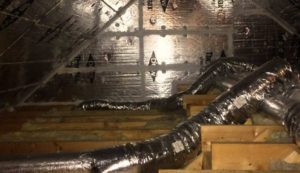
SOLUTIONS
Cooling Off A Hot Attic
Steps you can take to cool down your attic – and your whole house!
Read More…
A retrofit example that works
I believe the best solution may be a combination of radiant barrier to stop the sun’s heat from warming up the attic structure to begin with along with proper ventilation, attic exhaust fan(s), insulation and air sealing.
1. Seal off any air leaks at the ceiling. This prevents air/dust movement from living space to attic. This will also prevent excessive moisture from migrating in and out of your attic.
2. Install additional insulation to bring the total to over R-30 everywhere-even over the access hatch. Cover the tops of any wood ceiling joists by at least 3 inches.
3. Make sure the eave, gable and ridge vents are wide open and unobstructed.
4. Install radiant barrier foil between the rafters. You will need to allow the foil to “sag” at least an inch below the sheathing to allow an air space. You can get radiant barrier foil from Amazon here.
A reader Ken from Tennessee sent in his experience:
On my attached pictures I’m showing around 30 degrees on the sunny side and only 3 degrees on the shaded side.. I have a ridge vent and roof edge vents, because the contractor forgot to put soffet vents onto the house. Pictures were taken on December 12 2015, in eastern Tennessee. No attic fan.
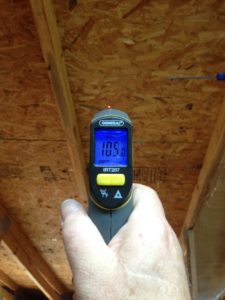
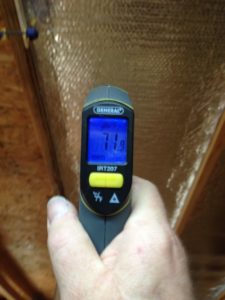
On the shady side of the roof, the results were as follows:
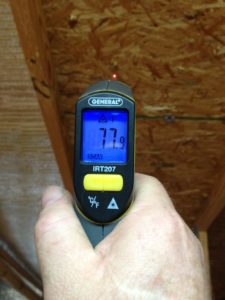
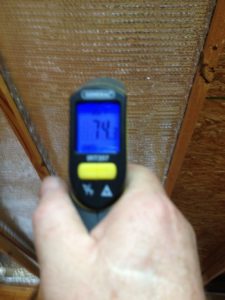
Summary
If you your house has a hot attic and ceilings during the summer, the solution is a system and not simply a powered attic exhaust fan or ventilator. To eliminate a hot attic you should consider a plan that includes radiant barriers and proper ventilation This is always best done when the home is under construction. Once constructed it may be difficult or impossible to retrofit this without major work to the structure.
What you must do is prevent heat from migrating down into the home. Your plan will likely require a completely sealed ceiling, a very thick layer of insulation, radiant barriers (reflective foil layers) above the insulation (preferably between the rafters) to block the radiation and isolate your hot attic from your cool house, additional ventilation openings and possibly a powered attic fan to remove warm air from the attic at the proper exchange rate.
Consider another, even better solution, the conditioned-space attic. Our client from above eventually opted to create a conditioned-space in their attic using a foam insulation applied to the pitched roof. This created a completely cool attic, dramatically reduced power bills and easy to maintain temperatures in the second floor rooms. Although their plan cost a bit more, this solution delivered a totally cool and comfortable second floor. I will publish more details on this option later.


